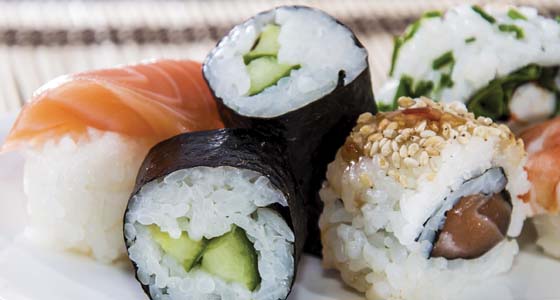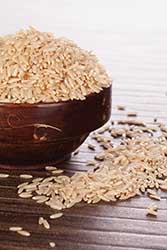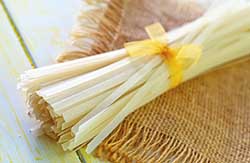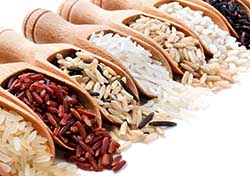Reinventing Rice
INGREDIENTS

Rice is a staple product widely consumed by a great percentage of the world’s population, and the cultivation of it is an income source for millions of people worldwide. Over the years, each culture that cultivated rice developed different varieties of the grain and different ways to incorporate it into the local cuisines and customs. India is known for Basmati rice, the Japanese use a particular short-grain white rice sometimes called japonica rice or sushi rice to make sushi and ferment rice to make sake, Cambodians serve rice banana cake at weddings and other special occasions, Vietnamese and Thai people use rice flour and water to make dough for rice paper used in spring rolls, and the various cultures throughout Latin America, where a wide assortment of rice dishes are served, have their own versions of arroz con pollo (chicken and rice) and other rice and meat/fish/legume combinations. Diners across America may begin seeing more rice served as side items, according to the National Restaurant Association’s 2014 What’s Hot Culinary Forecast, which lists black/forbidden rice and red rice as varieties that are trending on restaurant menus.
Rice is more than a main meal or side dish though. Ingredient manufacturers are developing new ways to use components of rice like starch, protein, fiber, and bran and utilize rice oils, flours, and syrups in a variety of applications. What follows is an overview of some of these rice ingredients that can enrich food and beverage products with nutrients, improve textural attributes, replace common food allergens, function in gluten-free formulations, act as a thickening agent, reduce syneresis, and more.
Increasing Protein with Sprouted Brown Rice
Sprouting grains increases amounts of many nutrients found in the grains like B vitamins, vitamin C, folate, fiber, and essential amino acids, according to the Whole Grains Council (WGC), Boston, Mass. (www.wholegrainscouncil.org). Rice is one of the grains that is available in sprouted form, and WGC points out research on the health benefits of consuming this sprouted grain such as positive effects of controlling blood sugar, lowering the risk of cardiovascular disease, and better overall well-being and immune system function in nursing mothers.
AIDP Inc., City of Industry, Calif. (www.aidp.com), promotes its sprouted brown rice protein ingredient, Gabiotein A™, as a nutrient-packed protein alternative to whey, soy protein, and other foods that cause food allergies or sensitivities, useful in formulating foods for vegan consumers, and a cost-effective protein source. Two groups are driving the rice protein market, says Kathy Lund, Vice President of Business Development and Marketing for AIDP. Consumers want alternatives to animal protein for health reasons or have adopted vegetarian or vegan diets, and food manufacturers are looking for ingredients that can increase protein content of their products.
In addition to this variety of health benefits, Gabiotein A also has other attributes to help product developers in their formulation efforts. When formulating any food or beverage product, achieving optimum taste and texture is key, and sometimes adding additional ingredients can negatively affect the product. The Gabiotein A ingredient, which is available in 80% and 90% protein contents, is said to provide a smooth texture and neutral taste, color, and aroma to a finished product without altering the original taste and texture of that product. It also remains suspended in liquid longer than other rice proteins. Product categories that can feature Gabiotein A are bars, powdered shakes, soups, pastas, ready-to-drink beverages, cereals, and sweet and savory snacks. “There is a huge amount of creativity that is driving interest in rice protein,” states Alan Rillorta, Director of Branded Ingredients Sales for AIDP.
Rillorta points to something that he calls “farm fresh” that helps differentiate AIDP in the marketplace. “The rice from our farms that we control comes into our facility and is made into rice syrups and starches while the protein-enriched secondary stream is going to our protein manufacturing facility where it is made fresh into protein at the same time.” He also notes that since AIDP is vertically integrated from the farm to the manufacturing and processing facility, and therefore has control over the farms that grow the rice, the equipment that is used, and the manufacturing facility, “there is no opportunity for contamination.”
--- PAGE BREAK ---
Usefulness of Rice Starches
Rice starches provide a variety of texture options to food and beverage applications, from smooth and creamy to crispy and crunchy. Take PenCling® 327 modified waxy rice starch from Penford Food Ingredients, Centennial, Colo. (www.penford.com), for instance. This ingredient has high viscosity, water-holding capacity, and binding abilities and can produce cheese and cream sauces, dairy desserts, and bakery fillings with the creamy texture that consumers desire from these products. Ingredients like PenPure® 30 native regular rice starch and PenPure 37 native waxy rice starch can provide smooth texture to soups and sauces and creamy mouthfeel to infant foods. PenPure 30 also adds crispness to extruded snacks while PenPure 37 can enhance the texture of gluten-free coatings.
In addition to their texture-enhancement and improvement capabilities, rice starches offer other functionalities. A pre-gelatinized unmodified waxy starch, PenPure WR replaces fat in instant or cold processed fillings, thickens dips and spreads, and improves gluten-free raw dough handling. Manufacturers of extruded snacks can expect the ingredient to function as a binder and enhance expansion. PenPlus® 390 modified pregelatinized waxy rice starch can help improve the viscosity in yogurt, sour cream, cream cheese, and cottage cheese. It aids the elasticity of tortillas and makes them easier to roll on the manufacturing line.
Rice Fiber Enriches Diets
Many nutritionists agree that Americans are not consuming enough fiber to meet the daily recommendations. Ingredient manufacturers offer an array of fiber ingredients derived from a number of different sources, and they continue to improve upon the developments. A particular rice fiber ingredient, SunOpta Rice Fiber 310, from SunOpta Ingredients Group, Chelmsford, Mass. (www.sunopta.com/ingredients), is processed in a way that allows it to have more than 90% fiber. Milling rice involves removing the hull to expose the brown rice kernel. SunOpta uses a proprietary hydrothermal process on the hulls to produce a highly concentrated functional fiber.
The fine powder ingredient has moderate water holding capabilities and neutral flavor. SunOpta promotes the ingredient’s ability to enhance texture, control moisture, and increase the fiber content of foods. Product developers can use it to fortify baked goods, cereals, extruded snacks, crackers, tortillas, nutrition bars, bread, and baking mixes. Since it is gluten free, the ingredient is useful in a number of products formulated for consumers following a gluten-free diet.
 Alternative to Animal Protein Found in Brown Rice
Alternative to Animal Protein Found in Brown Rice
Brown rice is prized by both health-conscious consumers and culinary professionals for its whole grain content, amount of nutrients that have potential benefits of reducing the risk of certain diseases, and chewy texture and nutty flavor. Several of the ingredient developments mentioned in this article are derived from brown rice, and Axiom Foods Inc., Los Angeles, Calif. (http://axiomfoods.com), manufacturers a range of whole-grain brown rice-based ingredients like rice bran, rice bran oil, rice flour, and liquid and powder nondairy rice milks. One of its more popular ingredients, and the one getting attention by researchers studying its possible nutrition benefits, especially for athletes, is Oryzatein® brown rice protein powder. The company reports that Oryzatein is an effective option to whey protein isolate for muscle building and repair. By using the plant-based protein ingredient, food formulators can appeal to vegetarian consumers and consumers who want products made with alternatives to animal protein. Axiom Foods uses a proprietary low-heat, hexane-free process to enzymatically extract the protein from multiple layers of the whole grain.
Axiom Foods is also working to educate consumers about heavy metals in food. The company in February 2014 began a campaign to let people know that heavy metals occur naturally in plant foods like rice and to reiterate the benefits of its heavy metals management program. Heavy metals enter food through the soil or water, and the body has mechanisms in place that help the body absorb or filter out heavy metals. Some like iron, copper, manganese, zinc, and others are not necessarily toxic and are actually required by the body in trace amounts as essential nutrients, reports the company. Since there are heavy metals that could reach toxic levels in the body, Axiom Foods is highlighting the ways in which it is helping to reduce the amounts of heavy metals in foods. These include sourcing the rice and other food ingredients from geographic areas that tests show have lower levels of heavy metal occurrence, testing the products in accredited labs using the latest standards, and utilizing new procedures and technologies to help reduce the amount of heavy metals throughout all stages of production.
Rice Finds Function in ‘Free-from’ Foods
Consumers around the world are more aware of food allergies and food intolerances, which is driving the market for “free-from” food and beverage products. Mintel GNPD found that 75% of adults in the world have reduced lactase activity. Reports of allergies to foods like soy, wheat, and tree nuts are also increasing, as are the numbers of people self-diagnosing food intolerances or choosing to buy “free-from” products, citing a number of health reasons for doing so, reports Stefanie De Roover, Nutriz Product Manager for BENEO, Mannheim, Germany (www.beneo.com). Add to this the U.S. consumers who do not use soy-based dairy alternatives because they do not like the taste and it is easy to see why rice ingredients can meet the needs of consumers looking for non-allergen, lactose-free, and gluten-free alternatives to dairy, wheat, and soy.
--- PAGE BREAK ---
 BENEO’s line of Nutriz rice powders and concentrates offers product developers an alternative to dairy ingredients in applications like beverages, whipped nondairy desserts, bakery creams, ice cream, and confectionery. Derived from rice syrup, rice oil, rice flour, rice starch, and rice protein, the Nutriz ingredients are lactose- and gluten-free and can be classified as “allergen-free,” reports De Roover. The powder is similar in sweetness to milk powder, making it suitable for use in sweeter applications like ice cream and custard. The concentrate’s blend of carbohydrates, unsaturated fatty acids, proteins, and vitamins can help in formulating a nutrient-rich rice milk product with a creamy mouthfeel, adds De Roover. BENEO has demonstrated the effectiveness of the Nutriz ingredients in product concepts like a lactose- and cholesterol-free fermented strawberry rice drink and vanilla-flavored rice milk at the Drinktec 2013 show.
BENEO’s line of Nutriz rice powders and concentrates offers product developers an alternative to dairy ingredients in applications like beverages, whipped nondairy desserts, bakery creams, ice cream, and confectionery. Derived from rice syrup, rice oil, rice flour, rice starch, and rice protein, the Nutriz ingredients are lactose- and gluten-free and can be classified as “allergen-free,” reports De Roover. The powder is similar in sweetness to milk powder, making it suitable for use in sweeter applications like ice cream and custard. The concentrate’s blend of carbohydrates, unsaturated fatty acids, proteins, and vitamins can help in formulating a nutrient-rich rice milk product with a creamy mouthfeel, adds De Roover. BENEO has demonstrated the effectiveness of the Nutriz ingredients in product concepts like a lactose- and cholesterol-free fermented strawberry rice drink and vanilla-flavored rice milk at the Drinktec 2013 show.
During the 2013 Food Ingredients Europe (FiE) show, BENEO showcased information about how its ingredients could contribute to healthy living across all stages of life. One stage that focused on the company’s rice ingredients was infancy. The company in 2013 introduced a rice starch specifically formulated for use in jarred baby food. Rice is easy to digest and is not considered a food allergen, which makes it an ideal ingredient in baby foods, according to BENEO. When used in both vegetable and fruit baby food formulas, the starch has provided improved stability in viscosity, syneresis control, and shelf life. The resulting texture of the baby food is creamy due to the ingredient’s small particle size.
RiceBran Expands Production Operations
RiceBran Technologies, Scottsdale, Ariz. (www.ricebrantech.com), in the spring of 2014 is set to complete a major expansion project of its rice bran oil bio-refining facility for its subsidiary, Ingovel—Industria Riograndense de Oleos Vegetais, in Pelotas, Brazil. The project included increasing the facility’s raw rice bran processing capacity by more than 50% in addition to many other upgrades and new additions to help meet the growing global demand for rice bran oil. What is driving this demand are the reported health benefits of rice bran oil and functional benefits such as a high smoke point in frying applications, according to the company.
In addition to rice bran oil, RiceBran Technologies produces a number of ingredients made from rice bran, which it showcased at the 2014 Natural Products Expo West. For its Proryza™ P-35 rice bran protein and PF-20/50 rice bran and fiber ingredients, the company processes the bran layer and germ of brown rice to retain beneficial vitamins, minerals, antioxidants, and phytosterols. The P-35 ingredient has 35% protein and is a source of essential amino acids like leucine, which is used for muscle recovery after exercise, and arginine, which is important for protein synthesis. The ingredient’s protein content and its mild nutty and honey flavor profile make it ideal for protein enhancement in beverages, sports nutrition products, bars, cereals, and weight management products. The PF-20/50 ingredient contains 20% protein and 50% dietary fiber in the form of insoluble dietary fibers cellulose, hemicellulose, and lignin. Like the PF-35 ingredient, the PF-20/50 ingredient contains amino acids used for growth and muscle maintenance.
One of the key ingredients in RiceBran Technologies’ portfolio is RiBran rice bran and germ, which is processed using proprietary methods so as to deactivate lipase, a naturally occurring enzyme in the bran layer that causes rancidity. Available in three particle sizes (coarse, fine, and extra-fine granules), the ingredient provides a number of functionalities in bakery and meat applications. Product developers can expect moisture retention and increased shelf life in cake applications, a soft texture and improved crumb texture in wheat bread, improved binding qualities of dough and better crumb structure in butter shortbread, and higher yields and moisture control in pizza crust dough. The ingredient’s fiber content even allows for fiber claims. The versatility of the ingredient’s functionalities is also showcased in smoked sausage by binding fat, in hot dogs by reducing purge, and in chicken nuggets by reducing oil uptake without affecting the sensory characteristics of the finished products, reports the company. Lastly, the RiBran ingredient can replace soy protein isolate, soy protein concentrate, modified food starch, mustard flour, and pea protein.
The company’s line of rice bran derivatives rounds out its ingredients offerings and allows product developers to add nutrients and fiber to breads, pastries, tortillas, pasta, and more. RiSolubles® is a water-based soluble fiber fraction from rice bran for use in dairy-based beverages, energy drinks, baby foods, and hot cereals. RiBalance® is processed from rice bran using proprietary technology to make nutrients more bioavailable. It functions in applications like nutrition and energy bars and cereals. RiFiber, an insoluble fiber fraction from rice bran with more than 40% total dietary fiber, enriches the fiber content of beverages, cereals, and baked goods.
--- PAGE BREAK ---
 Rice Ingredients Keep Labels Simple
Rice Ingredients Keep Labels Simple
Consumers continue to challenge food manufacturers to produce food and beverage products that are made with the fewest possible number of ingredients and with easily recognizable names. This emphasis on “clean label” products has driven ingredient manufacturers to develop and market certain ingredients as effective replacements for other ingredients. Take RIBUS Inc., St. Louis, Mo. (www.ribus.com), for example. It created a number of rice ingredients that can replace ingredients such as monoglycerides, enzymes, soy lecithin, silicon dioxide, and more, helping aid product developers in their reformulation efforts.
An ingredient like Nu-RICE®, a water-soluble powder derived from rice bran, functions as an emulsifier and hydration aid in extruded cereal and snack products, pasta, and high-protein or high-fiber bars. Formulating with the ingredient is said to help improve water distribution, uniformity, and texture of the finished products. In addition to this, Nu-RICE® has emulsification properties like the ability to emulsify oil in water, increase the expansion of extruded products, and increase extrusion output. The ingredient can replace soy lecithin, monoglycerides, and diglycerides and be listed on the ingredient statement as “rice extract,” helping product developers formulate clean label products that consumers demand.
RIBUS also promotes a rice-based ingredient especially for bakery applications. Nu-BAKE® replaces soy lecithin, monoglycerides, diglycerides, and trans fatty acids, and it replaces up to 50% of eggs. The combination of glycolipids, proteins, starches, and pentosans gives the ingredient its emulsification and texture-enhancement properties. Manufacturers can label the ingredient as “rice bran extract” or “rice extract.”
Two other ingredients function as processing aids. Nu-FLAC® is made from rice hulls or rice husks. It contains about 18–20% silica that occurs naturally, making it useful as a plating agent and flavor carrier. The other ingredient, Nu-FLOW®, is a fine powder made from sterilized and ground rice hulls that functions as an anti-caking agent, replacing silicon dioxide and tricalcium phosphate in spices and seasoning blends. RIBUS offers Nu-FLOW in an organic version as an alternative to silicon dioxide, which the U.S. Dept. of Agriculture in 2013 added to the list of prohibited substances used in most organic food production and processing when it amended the USDA National List of Allowed and Prohibited Substances (it can be used only in certain instances).
 Rice Varieties Meet Culinary, Product Development Needs
Rice Varieties Meet Culinary, Product Development Needs
Chances are that during a trip to the local grocery store or supermarket consumers are sure to see at least one of the branded rice products available from Riviana Foods Inc., Houston, Texas (www.riviana.com). These include rice brands like Mahatma®, Success® Rice, Minute® Rice, Carolina®, River® Rice, Water Maid® Rice, and Gourmet House®.
The company is also a leading producer of rice and rice ingredients used by food manufacturers around the world. Instant rice is rice that has been precooked and dehydrated so it cooks in about 5–10 minutes, and Riviana has several varieties useful in applications like frozen dinners where a 5-minute rehydration time is required and microwave and meal-in-cup applications where hot water will rehydrate the rice. Parboiled rice, which is produced by partially boiling rice in the husk, is more resistant to overcooking or over-processing as the parboiling process partially gelatinizes the starch. It is most often used in canned soups, rice mixes in retort pouches, or products that require additional processing. Milled rice is generally white rice with the rice bran layer and germ removed, producing fluffier rice that is white or light yellow in color. Wild rice was once prized by Native Americans in parts of North America, according to Riviana, and today culinary professionals and food product developers consider it the “gourmet grain” for its exceptional nutritional value, flavor (smoky and nutty with roasted notes), texture (tender and chewy or firm and chewy), and appearance (black and various shades of brown).
Rivland Partnership, a joint venture between Riviana Foods and Riceland Foods Inc., provides a comprehensive collection of rice flour ingredients with specific functionalities. Ingredients like Rice Flour RL-100 and Rice Flour RM-100 are neutral in taste and aroma, making them suited for applications where product developers want minimal effects on flavor. RL-100 is made from long-grain varieties of rice and is used in baby food, ready-to-eat cereals, extruded snack foods, and pancake and waffle mixes. The high amylopectin content in RM-100, which is derived from medium-grain rice, helps to reduce syneresis in sauces, gravies, and puddings. Two ingredients derived from brown rice—Natural Brown Rice Flour and Parboiled Brown Rice Flour—lend a slight brown rice taste and nutty aroma to ready-to-eat cereals, granola bars, and breads. Rivland’s Rice-Gel® L-100 is processed precooked rice flour that offers thickening, binding, extending, and freeze-thaw stability properties.
Rice is an incredibly versatile food. Whether it is eaten alone or accompanied by meat or vegetables, topped with savory or sweet sauces, featured in desserts, used to make noodles, fermented to create vinegar, or incorporated into beverages, rice continues to be a food of sustenance and a culinary delight. Rich in nutrients, available in a variety of colors, and offering different textures and flavors to applications, rice is a source of ingredient development inspiration, as ingredient manufacturers continue to reinvent rice to provide solutions to product development challenges.
Next month’s Ingredients section will provide a preview of some of the ingredient offerings to be showcased at the IFT Annual Meeting & Food Expo in New Orleans, June 21–24.
Providing Nutrients to Those in Need
The Wright Group, Crowley, La. (www.thewrightgroup.net), offers a number of rinse-resistant rice premixes and standardized enrichments for the fortification of rice, particularly rice that is used to feed impoverished people in many emerging countries worldwide. The first, Vit-A-Rice®, specifically addresses vitamin A deficiency—the cause of childhood blindness and neural tube defects among these people—by providing the adult recommended daily intake of this essential nutrient. The second, called Iron Rice®, is a grain-based fortificant that contains iron and several other nutrients. The final ingredient, Nutra Rice®, provides a recommended daily intake of many essential nutrients such as vitamin A, folic acid, and iron. Made using rinse-resistant grain technology, these ingredients maintain their nutritional value even after they are cooked or exposed to hot and moist environments.
www.ift.org
Members Only: Read more about rice online at www.ift.org. Type the keyword into our search box at the upper right side of our home page.
 Karen Nachay,
Karen Nachay,
Senior Associate Editor
[email protected]
